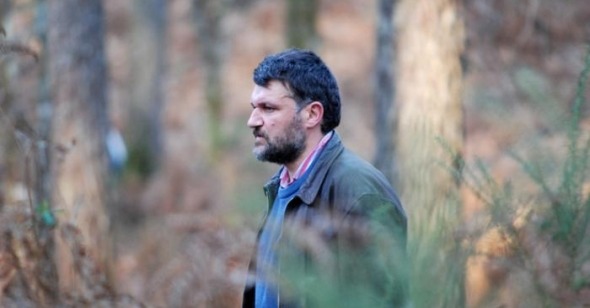Just Shoot Me
By Leo Goldsmith
Bullet in the Head
Dir. Jaime Rosales, Spain/France, no U.S. distributor
Cinema is a time-based medium, and duration is one of its great weapons. Sitting in a darkened theater, the passive consumer of movies is beholden to the whims of the filmmaker, forced to wait for the punchline, the kiss, the bump in the night. A certain narrative ideal holds that the patience of the spectator ought to be rewarded by the film—expectations should be satisfied and suspense itself suspended. This is why a lot of people go to the movies—to have some particular anticipation coddled and indulged—and thus the avant-garde has a fine tradition of upending and manipulating these basic narrative presumptions and desires of the audience. Films like Chantal Akerman's Jeanne Dielman, 23 Quai du Commerce, 1080 Bruxelles or Warhol's Empire work the fortitude of the spectators' attention spans, forcing viewers into extended durations of supposed everyday life, casual cinematic observation, or non-narrative formal play. Such denials of storytelling’s traditional push-and-pull provoke careful consideration of the narrative forms they’re unmasking.
This is all to say that Jaime Rosales's Bullet in the Head is tedious, but not simply because it's long and almost entirely devoid of incident. It's "experimental" in two senses of the word: in that it tests our patience in that certain avant-garde way, and in that the filmmaker doesn't really seem to know what he's doing, and is more hoping for a certain ingrained reaction rather than trying more actively to achieve it. To be sure, Rosales forces us to take a closer look at the everyday and to reconsider the nature and provenance of filmed images. His means of provoking such thought, however, brings nothing new to the table—indeed, his is a painfully old-fashioned trick, a game played many times before, by far more thoughtful filmmakers with greater commands of and ideas about their medium.
Before we get any further, a synopsis: We watch a large, middle-aged man (whom we discern is a Spaniard) from a discreet distance as he meets a woman and her child (possibly his?), meets some friends, goes to a party, makes out with a woman, has dinner with other friends, takes a trip across the border to France, etc. We are far enough away from him at all times—across the street, across a railway platform, outside his apartment —that we never hear a word he says (until somewhere toward the end of the film), and he is often obscured briefly by foreground objects—cars, passersby, sides of buildings, trees. This persists for one full hour in which almost nothing of particular significance occurs, until—bang!—he swears and then does something unexpected. (Hint: it has something to do with the title.) The rest of the film is spent following him around in the aftermath of this action. This section is shot in precisely the same way as the first portion of the film, except that it lasts a generously brief 20 minutes.
The expected reaction from critics to Bullet in the Head is to say, "Nothing happens!" to which the filmmaker will likely respond, "Oh, but that's not true!" But actually, it is true: the first hour of the film has almost nothing to do with the last 20 minutes; there is nothing about the first part (but for some very minor, uninteresting details) that the end of the film will force you to reconsider (à la The Usual Suspects, a witty, but creatively cashed-out narrative ploy in any case). While Bullet in the Head forces us to wonder about the source of the images (are we surveilling this man and his actions? Are we, the humble viewers, spies?), there is no reason to return to them later.
And this, for a few reasons, is the basic flaw in the experiment. First, in order to craft something like a deconstructionist "thriller," Rosales has lifted this device more or less directly from Michael Haneke's infinitely superior Caché, but fails to inject his film with any nuance in performance, any information, or anything at all to keep us interested in attending to the frame. Second, the source of the image has no value either diegetically or non-diegetically, so we are not prompted to interrogate how we came to be watching these images any more than we would in an ordinary thriller.
Worst of all, however, is the filmmaker's obvious lack of engagement with the cinematic form itself. A film like Bullet in the Head presumes a particular kind of audience—a festival audience—a group of people who know little about the film before going into it, who are watching the film in a movie theater rather than on DVD, and who are more or less forced to put up with an utterly unrevealing hour's worth of scenes from the life of an otherwise uninteresting Spaniard. (Haneke's film, by contrast, is a totally assured work, and not in any way an experiment, not only because it integrates its more mysterious, "unmotivated" images into a narrative but also because it accounts for and incorporates the different ways films are watched and made.) As such, Bullet in the Head is an old-fashioned, very outmoded experiment with no concept of how films are watched or consumed these days, no life but as an ephemeral and annoying festival novelty, no reason to command more than a single viewing, if that. As a short, the film might have made some kind of impression, proved some fleeting and already well-established point about the nature of film spectatorship, or international terrorism, or surveillance. But unfortunately, Bullet in the Head is little more than one idea played out for about an hour too long, and without the option of fast-forwarding, the spectator's only possible recourse is to walk out of the theater.
